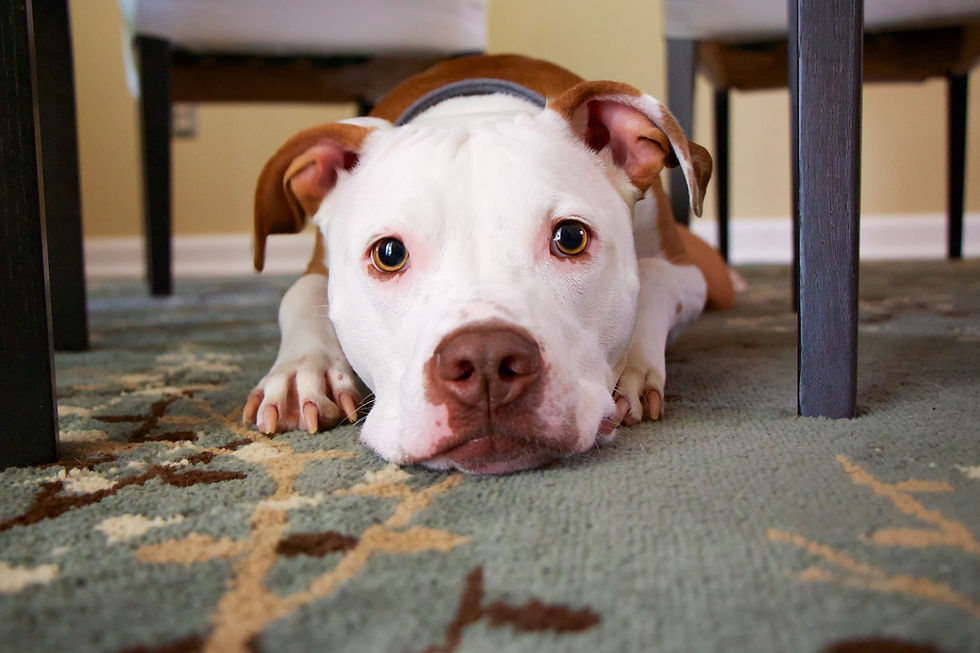How many times have you heard that comforting a fearful dog reinforces their fear? Here's why you should ignore that statement:

Fear is an emotion. Emotions are involuntary responses.
Reinforcement refers to an increase in behavior. Behaviors are voluntary responses.
Fear is something you feel. Behavior is something you do.
Here's an example: In the movie JAWS, actors had to appear to be afraid of a mechanical shark. Their eyes widened, they opened their mouths, they screamed. They were being paid to LOOK afraid, but they didn't actually become afraid of the fake shark. They could recreate the behaviors associated with fear, but they couldn't make themselves BE afraid.
Dogs, however, are not actors. They do not fake being afraid in order to get paid (attention, treats, invitation on the bed). If they are exhibiting the behaviors associated with fear, they are feeling afraid.
Don't believe me? Feel their chest and check and compare their heart rate to when you know they are relaxed. Dogs can't will their heart to beat faster just to get your attention.
Fear is an involuntary emotional reaction. For dogs, it can be triggered by fireworks, thunderstorms, veterinary exams, the behavior of other dogs, etc. Just because we can't perceive the threat doesn't mean it's not real to our dogs.
What about giving treats to a fearful dog? When we pair the presence of a scary stimulus (at a reasonable distance/intensity/duration, of course - desensitization is always important) with something the dog finds pleasant, we change the underlying association. The dog can learn to associate fireworks with frisbee time or vet visits with hot dogs. This is called counterconditioning (or classical counterconditioning).
Here's another example: You're terrified of spiders. We go to a local football field. While standing at one goal line, a person with a tarantula in a glass case appears at the other goal line. You see the spider. I give you $100. The spider goes away. Now, we repeat this multiple times. At some point, when the person with the spider re-appears, you will reach out your hand, anticipating payment.
Through this process of counter-conditioning, paired with careful desensitization, we can change your emotional response to the presence of spiders. Spiders predict cash.
That does not make you MORE afraid of the spider.
Now, can you CONTRIBUTE to your dog's fear? Absolutely!
If you don't recognize the signs of fear - or you do and ignore them - and force your dog into a situation that he is afraid of, you can certainly contribute to their fear. Like taking a fearful dog to a dog park to "get used to" other dogs, or picking up and holding a small dog that is afraid of strangers, so that strangers can pet him/her.
If we try to pet a fearful dog who just wants to leave the situation, holding them still and forcing "soothing" massage is just adding something unpleasant to an already bad situation. Listen to your dog. If your dog is leaning against you and seeking that physical contact, then he/she may be comforted by being stroked. But if your dog is looking away, leaning away, or otherwise trying to escape your well-meaning affection, you're better off just removing him from the situation.
When we take away opportunities for our dogs to escape or avoid the things they fear, we can make things worse.
Dogs don't "get used to" scary things through repeated and forced exposure. What they get used to is that we put them in situations where avoidance doesn't work, forcing them to protect themselves. When avoidance stops working, aggression is often the only option left.
And, yes, this applies to dogs whose fear manifests as aggressive behavior just as much as for dogs who cower and hide. Fear is the emotion behind the behavior. Change the emotion and the behavior will change, too.
One other point I wanted to make: If someone tells you that comforting your dog will reward their fear, replace the word "fear" with another emotion and ask yourself if it still makes sense. For example, "giving a dog treats just reinforces his frustration," or "petting your dog reinforces his disgust." Does that make sense? Like fear, frustration and disgust are feelings. No one can will themselves to be disgusted. If we could, diets would be SO much easier!
BUTS
Every single one of "But" comments I get about this article are based on personally-held beliefs.
Can you teach a dog to be afraid of something? Of course. You can create a negative association by pairing a neutral stimulus with an aversive. This was first proven in 1920 with the Little Albert study.
This is why knowledgeable trainers don't recommend using an aversive to "correct" a dog. Over 100 years of scientific research into learning has shown that you can create negative associations.
However, unless the form of comfort you give to your dog is AVERSIVE to your dog, you can't create a negative association.
And yet, over and over, there are those posting here who insist your response will "prove to the dog" there's something to fear. If that is your belief, ask yourself, how do you know that's what you're proving to the dog? Are you a dog psychic? No? Then the only way you can know what the dog is learning, either by association or consequence, is the dog's behavior. Is the dog showing an increase in fearful behaviors over time?
If so, you must also rule out the many variables before you can say with any certainty that petting your dog when fireworks go off are what caused/exacerbated the fear over, say, the repeated exposure, itself, sensitizing the dog.
While it is a longstanding and much-repeated belief in the training world (and there are so very many of them), it doesn't hold up to what science tells us about learning and behavior.
More:
Serenity Canine Behavior Ⓒ2022 Lisa Mullinax. All rights reserved.
serenitycanine.com
